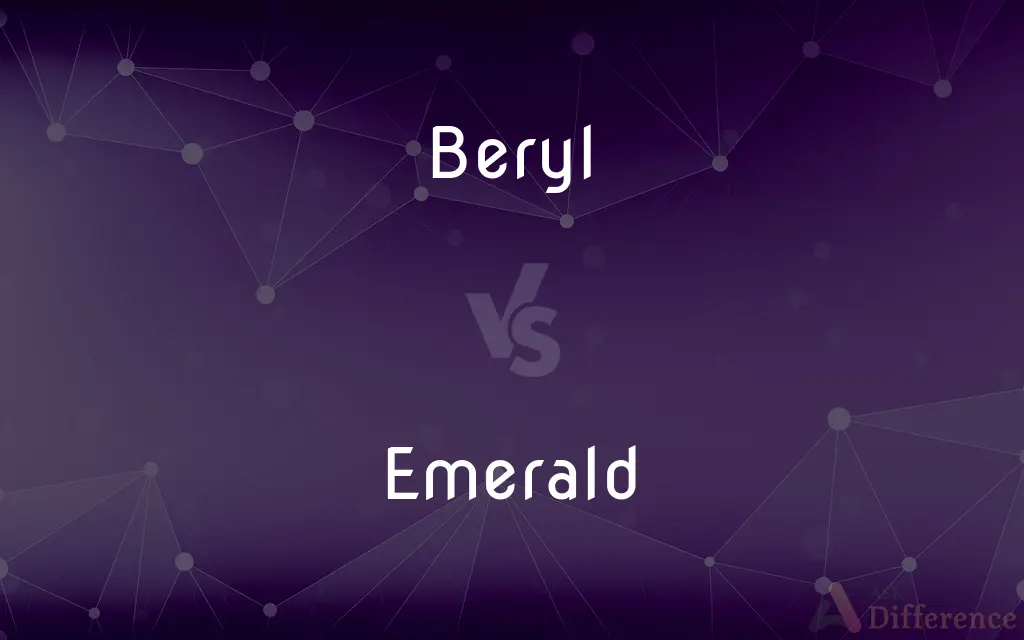Beryl vs. Emerald — What's the Difference?
Edited by Tayyaba Rehman — By Maham Liaqat — Updated on April 19, 2024
Beryl is a mineral composed of beryllium aluminum cyclosilicate with various gem-quality varieties, including emerald, which is distinguished by its vibrant green color due to chromium and vanadium impurities.

Difference Between Beryl and Emerald
Table of Contents
ADVERTISEMENT
Key Differences
Beryl is a broader category of minerals that includes a range of gemstones based on its color and impurities, each variety presenting a unique appearance. On the other hand, emerald is a specific variety of beryl characterized by its deep green color, which is one of the most valued and recognized gemstones.
In terms of composition, beryl is relatively pure beryllium aluminum cyclosilicate, which can appear colorless in its purest form, known as goshenite. Whereas emerald owes its green color specifically to traces of chromium and sometimes vanadium, making it distinct within the beryl family.
The clarity of beryl varieties can vary widely, with some forms like aquamarine often being almost free of inclusions. Conversely, emeralds are typically highly included, a trait that does not significantly detract from their value if the color is sufficiently rich.
Beryl is found in various locations around the world, often in granitic pegmatites and certain metamorphic rocks. On the other hand, high-quality emeralds are rarer and more geographically limited, with significant sources in Colombia, Zambia, and Brazil.
Regarding historical and cultural significance, various forms of beryl have been valued differently; aquamarine and morganite are popular in jewelry. However, emerald has a storied history of being one of the most coveted gemstones, often associated with royalty and luxury.
ADVERTISEMENT
Comparison Chart
Composition
Beryllium aluminum cyclosilicate
Beryllium aluminum cyclosilicate with chromium/vanadium
Color Variants
Colorless, blue, pink, yellow, etc.
Intense green
Typical Clarity
Varies, can be clear
Highly included
Geographic Occurrence
Found worldwide in pegmatites, metamorphic rocks
More limited, primarily in Colombia, Zambia, Brazil
Cultural Significance
Different varieties valued differently in jewelry
Historically valued by royalty, symbol of wealth
Compare with Definitions
Beryl
A mineral consisting of beryllium aluminum cyclosilicate, often colorless in its pure form.
The gemologist identified the sample as beryl due to its crystal structure.
Emerald
Often contains inclusions, which are tolerated if the color quality is high.
Despite the inclusions, the emerald’s color made it extremely valuable.
Beryl
Can appear in several colors including green, blue, pink, and yellow.
We admired the range of beryl colors available at the gem show.
Emerald
Mainly found in specific regions like Colombia, which is known for high-quality stones.
Colombian emeralds are prized for their unmatched color and clarity.
Beryl
Often used in jewelry, with varying value depending on the variety and clarity.
She chose a pink morganite beryl ring for its soft, romantic hue.
Emerald
Associated with luxury and historical significance, often favored by royalty.
The crown jewels include an impressive emerald set in a historic tiara.
Beryl
Known for varieties like aquamarine and morganite, based on color and impurities.
The blue to sea-green colors of aquamarine are due to iron impurities in beryl.
Emerald
A green variety of beryl colored by chromium and sometimes vanadium.
The emerald’s rich green is enhanced by the presence of chromium.
Beryl
Typically found in granitic pegmatites and certain metamorphic rocks.
The geologist found a significant deposit of beryl in the local pegmatite.
Emerald
Known for its deep green color, which is highly valued in jewelry.
He presented her with an emerald necklace of a vibrant, deep green shade.
Beryl
Beryl ( BERR-əl) is a mineral composed of beryllium aluminium cyclosilicate with the chemical formula Be3Al2Si6O18. Well-known varieties of beryl include emerald and aquamarine.
Emerald
Emerald is a gemstone and a variety of the mineral beryl (Be3Al2(SiO3)6) colored green by trace amounts of chromium and/or sometimes vanadium. Beryl has a hardness of 7.5–8 on the Mohs scale.
Beryl
A transparent to translucent glassy mineral, essentially aluminum beryllium silicate, Be3Al2Si6O18, occurring in hexagonal prisms and constituting the chief source of beryllium. Transparent varieties in white, green, blue, yellow, or pink are valued as gems.
Emerald
A bright green precious stone consisting of a chromium-rich variety of beryl
An emerald necklace
Beryl
A mineral of pegmatite deposits, often used as a gemstone.
Emerald
A bright green colour
The sea glistened in shades of emerald and jade
Beryl
(countable) An example (a stone) of the mineral beryl.
The crown was set with six beryls of excellent size and color.
Emerald
A slender-bodied green moth, the colour of which tends to fade as the moth ages.
Beryl
(uncountable) A dull blueish green colour.
Emerald
A hawker dragonfly with a metallic green body.
Beryl
Of a dull bluish green colour.
Emerald
A small hummingbird with bright metallic green plumage and darker wings and tail, found mainly in the area of the Caribbean and Central America.
Beryl
A mineral of great hardness, and, when transparent, of much beauty. It occurs in hexagonal prisms, commonly of a green or bluish green color, but also yellow, pink, and white. It is a silicate of aluminum and beryllium. The aquamarine is a transparent, sea-green variety used as a gem. The emerald is another variety highly prized in jewelry, and distinguished by its deep color, which is probably due to the presence of a little oxide of chromium.
Emerald
Bright green in colour
Beyond the airport lay emerald hills
Beryl
The chief source of beryllium; colored transparent varieties are valued as gems
Emerald
A brilliant green to grass-green transparent variety of beryl, used as a gemstone.
Emerald
A strong yellowish green.
Emerald
Of a strong yellowish green.
Emerald
Any of various green gemstones, especially a green transparent form of beryl, highly valued as a precious stone.
Emerald
Emerald green, a colour.
Emerald
Any hummingbird in the genera Chlorostilbon and Elvira; and some in the genus Amazilia
Emerald
(entomology) Any of various species of dragonfly of the family Corduliidae.
Emerald
A size of type between nonpareil and minion, standardized as 6½-point.
Emerald
Of a rich green colour.
Emerald
To ornament with, or as if with, emeralds; to make green.
Emerald
A precious stone of a rich green color, a variety of beryl. See Beryl.
Emerald
A kind of type, in size between minion and nonpare l. It is used by English printers.
Emerald
Of a rich green color, like that of the emerald.
Emerald
A green transparent form of beryl; highly valued as a gemstone
Emerald
A transparent piece of emerald that has been cut and polished and is valued as a precious gem
Emerald
The green color of an emerald
Common Curiosities
How does emerald relate to beryl?
Emerald is a specific variety of beryl, distinguished by its green color from chromium impurities.
What is beryl?
Beryl is a mineral composed of beryllium aluminum cyclosilicate, known for its various gem-quality types.
Where is beryl found?
Beryl is found worldwide, especially in granitic pegmatites and certain metamorphic rocks.
What makes Colombian emeralds special?
Colombian emeralds are renowned for their unparalleled vibrant green color and excellent clarity.
What are the typical inclusions found in emeralds?
Emeralds often have inclusions such as cracks and foreign crystals but are still highly valued if the color is deep and vivid.
What is the price range for beryl gems compared to emeralds?
While beryl varieties vary widely in price, emeralds generally command higher prices due to their desirability and rarity.
Why are emeralds considered so valuable?
Emeralds are valued for their rich green color and rarity, especially high-quality specimens from specific locales.
Can the color of beryl vary?
Yes, beryl can range from colorless to blue, green, pink, and yellow depending on impurities.
Are synthetic versions of beryl available?
Yes, synthetic versions of beryl, including emerald, are produced for various industrial and jewelry purposes.
How are beryl and emerald used in jewelry?
Both are popular in jewelry, but emeralds are particularly prized in high-end pieces due to their color and rarity.
Are there other varieties of beryl besides emerald?
Yes, other varieties include aquamarine, morganite, and heliodor, each with distinct colors.
What historical significance do emeralds have?
Emeralds have been cherished throughout history, often associated with royalty and wealth.
How should emeralds be cared for?
Emeralds require careful handling and cleaning due to their natural inclusions and brittleness.
What are the common treatments for emeralds?
Emeralds are often treated with oils or resins to enhance clarity and appearance.
Why might someone choose beryl over emerald?
Someone might choose beryl like aquamarine or morganite for its different colors or lower price point compared to emeralds.
Share Your Discovery

Previous Comparison
Debris vs. Dirt
Next Comparison
Series vs. EpisodeAuthor Spotlight
Written by
Maham LiaqatEdited by
Tayyaba RehmanTayyaba Rehman is a distinguished writer, currently serving as a primary contributor to askdifference.com. As a researcher in semantics and etymology, Tayyaba's passion for the complexity of languages and their distinctions has found a perfect home on the platform. Tayyaba delves into the intricacies of language, distinguishing between commonly confused words and phrases, thereby providing clarity for readers worldwide.
















































